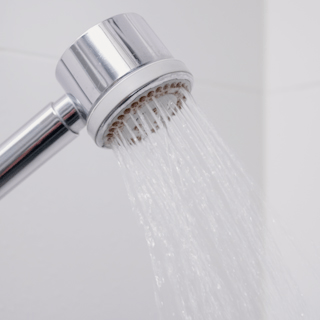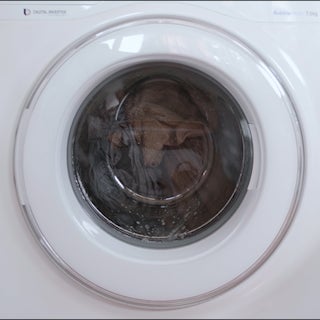Our most useful tip - be mindful of your water use. It's simple, the more we are aware of our water use, the less likely we are to waste it.
In the summer months for example, Aucklanders flock outdoors in droves. By nature, many of the activities we love to do outside involve water, and the hotter it gets, the more water we tend to use. By being mindful of our water use as the temperature gets up, we can help ease these summer pressures on our water network.
Whether you're prepping food in the kitchen or brushing your teeth in the bathroom: a conscious water-user is an economical water-user. By simply thinking about water while using it around your home, you will naturally become more efficient with it and play a huge role in protecting our environment and this precious resource.
Check out some of the work the Watercare team have been doing to manage and conserve our water supply.
Do your bit to save water
How to reduce water waste
around the home
Two key factors contribute to excessive water wastage around the home. These are your home’s water flow rate and undetected leaks. These can lead to unnecessary additional water use in all areas of the home and drive up your water bill. The first step on your journey to a water-efficient home is addressing these issues.
Your home’s water flow rate
Flow rate is the amount of water that flows from all your home’s taps and is measured in litres per minute. It differs from water pressure, which is the amount of force water moves through your pipes and taps. Water pressure is determined by your hot water cylinder, either on mains (equal) or low (unequal) water pressure. Measuring your home’s flow rate is easy and only takes a couple of minutes. Watch this 'how-to' video with EcoMatters Environment Trust.
Install flow restrictors
If you discover your home’s water flow rate is too high, you can install flow restrictors on taps and showers. These are widely available through plumbing and hardware stores. Prior to purchasing a water flow restrictor, we recommend chatting to a plumber to ensure such devices are compatible with your hot water cylinder. Hack your shower, saving water and power with EcoMatters Environment Trust.
Check your home for leaks
Dripping taps, dripping showerheads, and leaky toilets all contribute to water being wasted in the home. To assess whether your home has a leak, check whether the dial on your water meter is turning when no water is being used. You can detect small leaks with a simple overnight test. Read your meter at night before bed, then again first thing in the morning. If the meter number is higher in the morning, you likely have a leak. If you discover a leak, you then need to identify where it is.
Checklist:
- Check all taps, inside and outside the home.
- Look behind the dishwasher for any signs of water.
- In dry weather, look for damp patches in the garden, lawn, or driveway.
- Listen for running water inside your home when no taps, hoses, or showers are turned on.
- If you discover the source of a leak, get in touch with a registered plumber.
How to reduce water waste
around the home
How to save water
in the kitchen
Whether it’s washing dishes, cooking, filling the kettle, or just pouring a glass of fresh drinking water, the kitchen sees a lot of varied water use each day. With so many everyday tasks using water in the kitchen, there's a great opportunity for water reduction. Simply adjusting a few habits can go a long way to conserving water.
Don’t leave taps running while using the sink
While juggling activities in the kitchen, we often leave the tap running. Whether it's preparing food, peeling vegetables, thawing meat, or washing dishes, the kitchen tap often finds itself in constant use. But left running, the average tap uses 12 litres of water a minute! Instead, simply fill your sink with the water you need - you can even reuse this fresh water for multiple kitchen duties.
Stop rinsing your dishes before placing in dishwasher
An ingrained habit in many of us, rinsing your dishes before placing them in the dishwasher may be unnecessary. If your dishwasher is reasonably modern, it should be able to clean your dishes with no pre-rinsing. If your dishes are not clean after going through the cycle, you may need to clean your filters or repair your dishwasher. If you are handwashing dishes, fill your sink rather than washing under a running tap.
Reduce water flow of kitchen tap with a tap aerator
A simple tap aerator on your kitchen tap can reduce the flow of water into your sink. A swivel tap aerator has two flow settings and allows you to direct the water to where it is needed. A tap aerator will reduce water use without sacrificing the water pressure of your kitchen tap. Tap aerators are an inexpensive way to save water in the kitchen and available from hardware and plumbing stores.
Upgrade to an energy-efficient dishwasher
When the time comes to upgrade your current dishwasher, look for a dishwasher that is water efficient. Take note of your new dishwasher's water rating. Modern dishwashers use up to 60 per cent less water than older models. Dishwashers with five-star water ratings use as little as 7 litres of water per wash.
Be a water-wise cook
Be conscious of your water use while cooking. Use a bowl to scrub vegetables in the kitchen sink. You can then pour the water on your plants. Also, rather than running tap water over frozen food to thaw, let it defrost in the fridge for a few hours. If you are in a hurry, the microwave is a more efficient option than running water. You can also choose healthy ways of cooking that use less water. Steaming, or using a pressure cooker, keeps more nutrients in food and saves on energy and water.
Keep a jug of drinking water in the fridge
Running your kitchen tap while waiting for the water to be cold wastes many litres of water. Instead, keep water in a covered jug in the fridge. This saves running the tap to get cold water (and gives you delicious, ice-cold drinking water).
Ditch the InSinkErator for composting
If you have a built-in waste disposal unit in your sink, be aware that it will increase your water use. Why not compost your food waste instead? The Kaipātiki Project provides free composting courses throughout Auckland, funded by Auckland Council. The council also offers a discount on composting systems.
How to save water
in the kitchen
How to save water
in the bathroom
The bathroom is by far the biggest contributor to household water use. If we combine the average shower, bath, and toilet water use, almost 50 per cent of daily water consumption within the home is attributed to the bathroom. Luckily there are many simple ways you can save water here.
Reduce your shower time
The shower is not only the greatest water user in the bathroom but is responsible for 27 per cent of water use in the home overall. So, reducing water use in the shower will have the most significant impact on total bathroom water savings. The average time spent in the shower is eight minutes, but if every Aucklander reduced their shower time to four minutes the region would save 80 million litres of water per day! Using a shower timer is a great way to stay on top of shower water use.
Low-flow showerhead
Many older showerheads use a lot more water than is needed. Replacing your showerhead with a modern, efficient water flow rate will save water without compromising performance. Modern heads don't drop water pressure, but instead pull air into the water stream to give the same full pressure feeling while using a lot less water. To see a video about how water efficient showerheads are installed, check out EcoMatters Environment Trust.
Turn off your bathroom tap while brushing teeth or shaving
Many of us have the habit of leaving our bathroom tap running while shaving or brushing our teeth. This uses over five litres of water, every time. By simply turning the tap off while brushing our teeth or shaving, we can reduce this water use to just one litre – easy!
Check your toilet for leaks
The toilet may not seem an obvious place to save water, but a leaking toilet can waste about 80 litres of water per day. That’s like flushing your toilet seven times a day! Put a few drops of food colouring in the cistern. If colouring ends up in the toilet bowl without flushing, you have a leak. If you have it repaired you will notice significant water reduction in the bathroom.
Time to replace a toilet? Get a water-efficient, dual-flush toilet
If your toilet needs replacing, consider buying one with a dual flush. Check its water rating label. The latest four-star toilets use as little as three litres for a half flush and 4.5 litres for a full flush. Most toilets in Auckland use around seven litres per flush and older toilets use around 12 litres per flush.
Have a single-flush toilet? You can still conserve water!
If your current toilet is a single-flush, you can still save water by installing a gizmo. A gizmo is a simple, inexpensive weight that hangs inside the cistern tube and stops the toilet flushing when you take your finger off the button, meaning you can control how long each flush lasts. Find out more about the water-saving gizmo and get one for your toilet through EcoMatters Environment Trust.
How to save water
in the bathroom
How to save water
in the laundry
Up to one quarter of your household’s water is used in the laundry. The way we wash our clothes may seem very standardised, but our clothes washing habits and the use of older, inefficient technology sees hundreds of litres of water wasted in the laundry, every day. Older washing machines can use 200 litres of water per wash! Simply replacing an older machine for a front-loader can result in massive water savings in your home.
Switch from a top-loader washing machine to a front-loader
Front-loading washing machines typically use about 50% less water, 35% less detergent, and 30% less energy than equivalent-sized top-loading washing machines, making them the most cost-effective and water-efficient option. You can find this out by checking the water rating label. If you have a top-loader, your best tip is to be economical in how you wash your clothes.
Change to water-efficient settings on your washing machine
Another easy water-saving tip for the laundry is to use the economy settings on your washing machine. Reducing the wash to one rinse cycle rather than two will also save up to 100 litres of water per wash! That adds up if you calculate how many washes you do each year.
Don’t wash small loads - wash full loads
Washing a full load of laundry is the most water-efficient way to wash your clothes. If you don't have many items of clothing to wash, we recommend you wait until you have a full load ready. If you get caught out and absolutely must do a small load, make sure your washing machine settings are set for low water use. Remember: your machine will rarely default to an economy setting when switched on. You must do this manually.
Use a bucket and recycle water when washing clothes by hand
When handwashing clothes, use a bucket instead of leaving the tap running. You can reuse this water on your garden straight after (avoid the vegetable patch as this water may contain microbes). Using a biodegradable detergent with low phosphorus, sodium, and nitrogen will be better for your garden.
Don’t over-wash your clothes
Just because an item has been worn, doesn’t mean it requires washing. If your clothing shows no visible stains and passes the ‘smell test’ (used by mothers around the globe), place it back in your drawer for another use. This will not only save water in the laundry but also extend the life of your clothing and keep colours vibrant.



